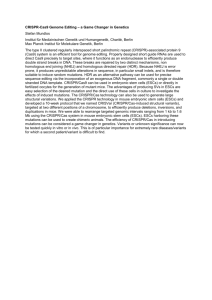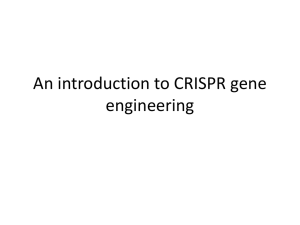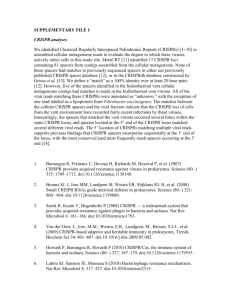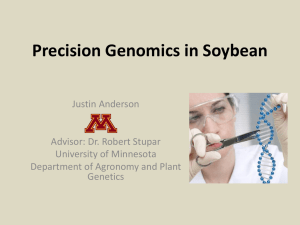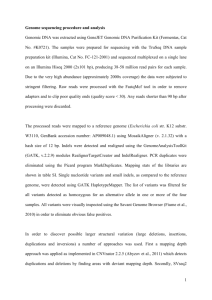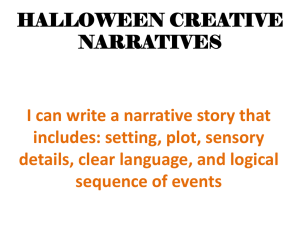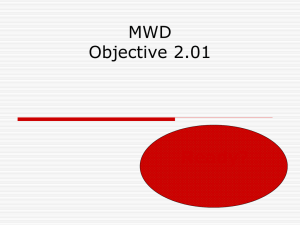crispr/cas9: a revoltionary tool for genome editing
advertisement
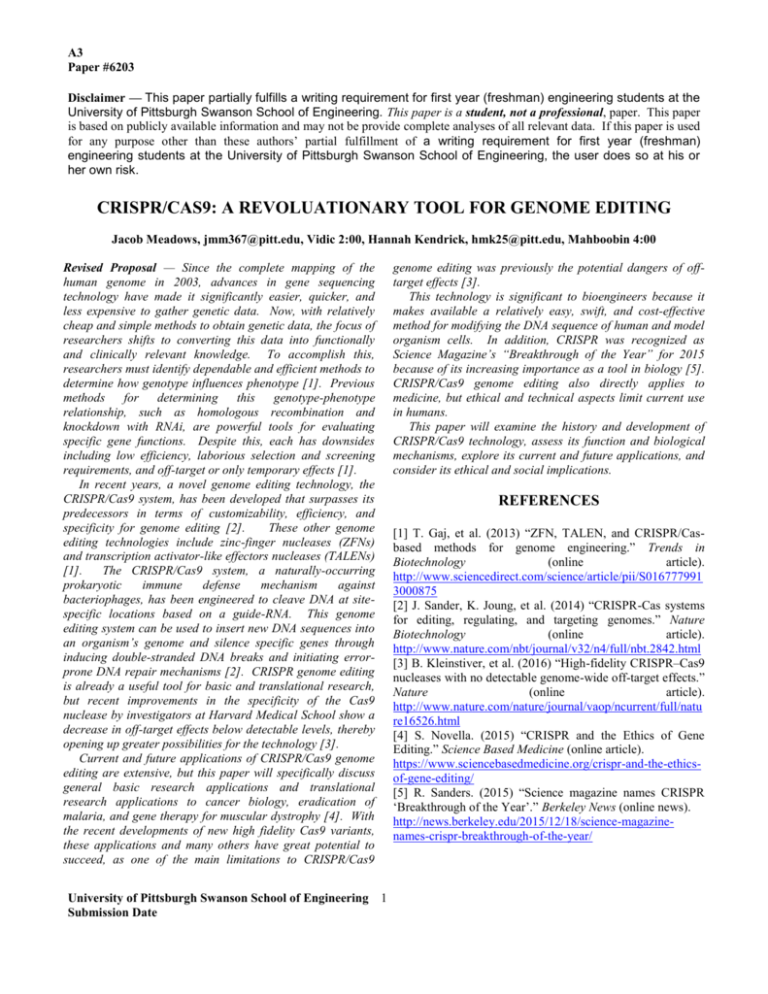
A3 Paper #6203 Disclaimer — This paper partially fulfills a writing requirement for first year (freshman) engineering students at the University of Pittsburgh Swanson School of Engineering. This paper is a student, not a professional, paper. This paper is based on publicly available information and may not be provide complete analyses of all relevant data. If this paper is used for any purpose other than these authors’ partial fulfillment of a writing requirement for first year (freshman) engineering students at the University of Pittsburgh Swanson School of Engineering, the user does so at his or her own risk. CRISPR/CAS9: A REVOLUATIONARY TOOL FOR GENOME EDITING Jacob Meadows, jmm367@pitt.edu, Vidic 2:00, Hannah Kendrick, hmk25@pitt.edu, Mahboobin 4:00 Revised Proposal — Since the complete mapping of the human genome in 2003, advances in gene sequencing technology have made it significantly easier, quicker, and less expensive to gather genetic data. Now, with relatively cheap and simple methods to obtain genetic data, the focus of researchers shifts to converting this data into functionally and clinically relevant knowledge. To accomplish this, researchers must identify dependable and efficient methods to determine how genotype influences phenotype [1]. Previous methods for determining this genotype-phenotype relationship, such as homologous recombination and knockdown with RNAi, are powerful tools for evaluating specific gene functions. Despite this, each has downsides including low efficiency, laborious selection and screening requirements, and off-target or only temporary effects [1]. In recent years, a novel genome editing technology, the CRISPR/Cas9 system, has been developed that surpasses its predecessors in terms of customizability, efficiency, and specificity for genome editing [2]. These other genome editing technologies include zinc-finger nucleases (ZFNs) and transcription activator-like effectors nucleases (TALENs) [1]. The CRISPR/Cas9 system, a naturally-occurring prokaryotic immune defense mechanism against bacteriophages, has been engineered to cleave DNA at sitespecific locations based on a guide-RNA. This genome editing system can be used to insert new DNA sequences into an organism’s genome and silence specific genes through inducing double-stranded DNA breaks and initiating errorprone DNA repair mechanisms [2]. CRISPR genome editing is already a useful tool for basic and translational research, but recent improvements in the specificity of the Cas9 nuclease by investigators at Harvard Medical School show a decrease in off-target effects below detectable levels, thereby opening up greater possibilities for the technology [3]. Current and future applications of CRISPR/Cas9 genome editing are extensive, but this paper will specifically discuss general basic research applications and translational research applications to cancer biology, eradication of malaria, and gene therapy for muscular dystrophy [4]. With the recent developments of new high fidelity Cas9 variants, these applications and many others have great potential to succeed, as one of the main limitations to CRISPR/Cas9 University of Pittsburgh Swanson School of Engineering 1 Submission Date genome editing was previously the potential dangers of offtarget effects [3]. This technology is significant to bioengineers because it makes available a relatively easy, swift, and cost-effective method for modifying the DNA sequence of human and model organism cells. In addition, CRISPR was recognized as Science Magazine’s “Breakthrough of the Year” for 2015 because of its increasing importance as a tool in biology [5]. CRISPR/Cas9 genome editing also directly applies to medicine, but ethical and technical aspects limit current use in humans. This paper will examine the history and development of CRISPR/Cas9 technology, assess its function and biological mechanisms, explore its current and future applications, and consider its ethical and social implications. REFERENCES [1] T. Gaj, et al. (2013) “ZFN, TALEN, and CRISPR/Casbased methods for genome engineering.” Trends in Biotechnology (online article). http://www.sciencedirect.com/science/article/pii/S016777991 3000875 [2] J. Sander, K. Joung, et al. (2014) “CRISPR-Cas systems for editing, regulating, and targeting genomes.” Nature Biotechnology (online article). http://www.nature.com/nbt/journal/v32/n4/full/nbt.2842.html [3] B. Kleinstiver, et al. (2016) “High-fidelity CRISPR–Cas9 nucleases with no detectable genome-wide off-target effects.” Nature (online article). http://www.nature.com/nature/journal/vaop/ncurrent/full/natu re16526.html [4] S. Novella. (2015) “CRISPR and the Ethics of Gene Editing.” Science Based Medicine (online article). https://www.sciencebasedmedicine.org/crispr-and-the-ethicsof-gene-editing/ [5] R. Sanders. (2015) “Science magazine names CRISPR ‘Breakthrough of the Year’.” Berkeley News (online news). http://news.berkeley.edu/2015/12/18/science-magazinenames-crispr-breakthrough-of-the-year/ Jacob Meadows Hannah Kendrick (online article). http://www.sciencedirect.com/science/article/pii/S016777991 3000875 This article, from a professional peer-reviewed journal focused on multidisciplinary applied biosciences, outlines the potential of ZFNs, TALENs, and CRISPR/Cas9 endonucleases to redefine the boundaries of biological research and influence the development of personalized medicine. The article details the history and differences between each genome editing technology and delves into the technical function and therapeutic applications of genome editing. Information from this article will help us establish an understanding of the technical aspects of genome editing and the recent developments in CRISPR/Cas9 technology. SOURCES CONSULTED J. Choi. (2013) “Genome Editing.” Stanford Huntington’s Outreach Project (online article). http://web.stanford.edu/group/hopes/cgibin/hopes_test/genome-editing/#what-is-genome-editing L. Cong, F. Ran, D. Cox, et al. (2013) “Multiplex Genome Engineering Using CRISPR/Cas9 Systems.” Science (online article). http://www.ncbi.nlm.nih.gov/pmc/articles/PMC3795411/ “How to Choose a Topic” (2015) University of Pittsburgh Library System (video) http://www.library.pitt.edu/other/files/il/fresheng/index.html E. Pak. (2014) “CRISPR: A game-changing genetic engineering technique.” Harvard Medical School SITN (online article). http://sitn.hms.harvard.edu/flash/2014/crispra-game-changing-genetic-engineering-technique/ S. Young. (2014) “Genome Surgery.” MIT Technology Review (online article). http://www.technologyreview.com/review/524451/genomesurgery/ B. Kleinstiver, et al. (2016) “High-fidelity CRISPR–Cas9 nucleases with no detectable genome-wide off-target effects.” Nature (online article). http://www.nature.com/nature/journal/vaop/ncurrent/full/natu re16526.html This article, from an international and interdisciplinary peer-reviewed journal, unveils the development of a novel high-fidelity CRISPR-Cas9 nuclease, SpCas9-HF1, which exhibits no detectable levels of off-target effects. The article explains why off-target effects from conventional Cas9 are a major impediment and how they reduced off-target effects such that it retained robust on-target activity but had diminished ability to cut incorrect off-target sites. Information from this article will be used to illustrate the increasing specificity of CRISPR-Cas technology and explain why the creation of SpCas9-HF1 is especially promising for genome editing applications. ANNOTATED BIBLIOGRAPHY J. Choi. (2013) “Genome Editing.” Stanford Huntington’s Outreach Project (online article). http://web.stanford.edu/group/hopes/cgibin/hopes_test/genome-editing/#what-is-genome-editing This article, from the Stanford Huntington’s Outreach Project, defines genome editing, lays out the underlying technical principals and explains some technologies such as zinc finger nucleases (ZFNs), transcription activator-like effector nucleases (TALENs), meganucleases, and CRISPR/Cas9. Information from this article will be used in our description of why CRISPR is a more efficient and less expensive technique of genome editing as well as explaining how CRISPR is proposed to be implemented therapeutically. S. Novella. (2015) “CRISPR and the Ethics of Gene Editing.” Science Based Medicine (online article). https://www.sciencebasedmedicine.org/crispr-and-theethics-of-gene-editing/ This article, from a website that explores issues and controversies in science and medicine, discusses the ethical implications of CRISPR and gene editing as a whole. The article summarizes the ethical considerations of CRISPR/Cas9 technology from multiple points of view and suggests medical applications of CRISPR that may be ethically controversial. Information from this article will help initiate a discussion on the ethics of CRISPR/Cas9 technology and how prominent scientists, engineers, and regulatory organizations advise proceeding with applying this technology to medicine. L. Cong, F. Ran, D. Cox, et al. (2013) “Multiplex Genome Engineering Using CRISPR/Cas9 Systems.” Science (online article). http://www.ncbi.nlm.nih.gov/pmc/articles/PMC3795411/ This article, published in a high-impact peer-reviewed scientific journal, details how the Zhang group at MIT used CRISPR/Cas systems with RNA guides to induce precise cleavage at endogenous genomic loci in human and mouse cells. This source shows the development of CRISPR/Cas prokaryotic immunity systems into genome editing tools and will be used to explain the history of origin of CRISPR/Cas9 technology. E. Pak. (2014) “CRISPR: A game-changing genetic engineering technique.” Harvard Medical School SITN (online article). http://sitn.hms.harvard.edu/flash/2014/crispra-game-changing-genetic-engineering-technique/ This article, from a Harvard Medical School scientific communication website, summarizes the steps of actually applying CRISPR/Cas9 technology and explains the role of T. Gaj, et al. (2013) “ZFN, TALEN, and CRISPR/Cas-based methods for genome engineering.” Trends in Biotechnology 2 Jacob Meadows Hannah Kendrick CRISPR in industry and academia. This article includes useful visual aids for understanding the function of CRISPR/Cas9 systems and will aid in our technical description of the process and the Cas9 enzyme itself, as well as applications in industry. J. Sander, K. Joung, et al. (2014) “CRISPR-Cas systems for editing, regulating, and targeting genomes.” Nature Biotechnology (online article). http://www.nature.com/nbt/journal/v32/n4/full/nbt.2842.html This article, from a professional and high-impact peerreviewed journal focused on biological technologies and methodologies, examines the function and use of the CRISPR/Cas9 system as a genome editing technology in detail and explains its significance to biological researchers. The article includes figures and explanations that detail the conceptual basis of CRISPR-Cas9 systems and the practical considerations for implementing CRISPR-Cas technology. Information from this article will be used to formulate comprehensive view of CRISPR/Cas9 function in biological systems and to point out potential pitfalls of the technology. R. Sanders. (2015) “Science magazine names CRISPR ‘Breakthrough of the Year’.” Berkeley News (online news). http://news.berkeley.edu/2015/12/18/science-magazinenames-crispr-breakthrough-of-the-year/ This article, from the University of California Berkeley News website, reports that Science magazine has named CRISPR the ‘Breakthrough of the Year’ for 2015. The article explains why CRISPR was so influential in 2015 and how this it has affected every area of genetics. Information in this article will be used to reveal the significance of the CRISPR/Cas9 technology to the general public and to emphasize how applications of CRISPR are already pervading into everyday life. S. Young. (2014) “Genome Surgery.” MIT Technology Review (online article). http://www.technologyreview.com/review/524451/genomesurgery/ This article, from MIT Technology Review, presents the pros and cons of CRISPR/Cas9 technology, TALENs, and ZFNs and explains how these pros and cons arise from their function and composition. The review also delineates approaches to cure sickle-cell anemia, HIV, and cystic fibrosis with these technologies and the current status of these endeavors. This information will be used in comparing CRISPR/Cas9 to other genome editing technologies and in discussing the potential gene therapy applications. 3
